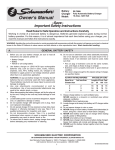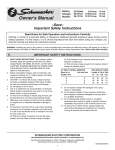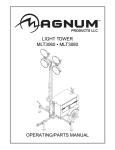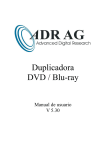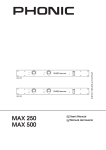Download Schumacher Electric SE-82-6 Owner`s manual
Transcript
Battery Charger Models: Owner's Manual SE-82-6 & SE-3002 6 and 2 Amp Battery Charger For 6 and 12 Volt Batteries –Save– Important Safety Instructions Read Rules for Safe Operation and Instructions Carefully Working in vicinity of a lead-acid battery is dangerous. Batteries generate explosive gases during normal battery operation. For this reason, it is of utmost importance that each time before using your charger, you read this manual and follow the instructions exactly. WARNING: Handling the cord on this product or cords associated with accessories sold with this product, will expose you to lead, a chemical known to the State of California to cause cancer and birth defects or other reproductive harm. Wash hands after handling. GENERAL BATTERY SAFETY 1. 10. Do not use an extension cord unless absolutely necessary. Use of an improper extension cord could result in fire or electric shock. If an extension cord must be used, make sure that: Before you use your battery charger, be sure to read all instructions and cautions printed on: • Battery Charger • Battery • Vehicle or unit using battery 2. 3. 4. 5. 6. 7. 8. 9. • Pins on plug of extension cord are the same number, size, and shape as those of plug on charger. • Extension cord is properly wired and in good electrical condition. • Wire size is large enough for AC ampere rating of charger, as specified below: _____________________________________________ Length of cord (feet): 25 50 100 150 AWG size of cord: 18 18 18 16 _____________________________________________ Use battery charger on LEAD ACID type rechargeable batteries only, such as used in autos, trucks, tractors, airplanes, vans, RV's trolling motors, etc. Charger is not intended to supply power to low-voltage electrical system other than in an automotive application. WARNING: Do not use battery charger for charging dry-cell batteries that are commonly used with home appliances. These batteries may burst and cause injury to persons and damage to property. Use only attachments recommended or sold by manufacturer. Use of non-recommended attachments may result in fire, electric shock, or injury. When disconnecting the battery charger, pull by the plug not by the cord. Pulling on the cord may cause damage to cord or plug. Locate battery power cord so it cannot be stepped on, tripped over, or subjected to damage or stress. Do not operate charger with damaged cord or plug. Have cord replaced immediately. Do not operate charger if it has received a sharp blow, been dropped, or otherwise damaged in any way. Take it to a qualified professional for inspection and repair. Do not disassemble charger. Take it to a qualified professional when service or repair is required. Incorrect reassembly may result in electric shock or fire. To reduce risk of electric shock, unplug charger from outlet before attempting any maintenance or cleaning. 11. Always charge battery in a well ventilated area. NEVER operate in a closed-in or restricted area without adequate ventilation. WARNING: Risk of explosive gas. 12. Locate charger as far away from battery as DC charger cables permit. 13. Do not expose charger to rain or snow. 14. NEVER charge a frozen battery. If battery fluid (electrolyte) is frozen, bring into a warm area to thaw before charging. 15. NEVER allow battery acid to drip on charger when reading specific gravity or filling battery. 16. NEVER set a battery on top of charger. 17. NEVER place charger directly above battery being charged. Gases from battery will corrode and damage charger. 18. NEVER touch the battery clips together when the charger is energized. 19. NEVER crank engine with charger attached to battery. SCHUMACHER ELECTRIC CORPORATION 801 BUSINESS CENTER DRIVE • MOUNT PROSPECT, ILLINOIS 60056-2179 Send Warranty Product Repairs to: 1025 E. Thompson, Hoopeston, IL 60942-0280 Call Customer Service if you have questions: 1-800-621-5485 00-00-000531/0103 1 PERSONAL PRECAUTIONS AND SAFETY 1. 2. 3. 4. 5. WARNING: Wear complete eye protection and clothing protection, when working with lead-acid batteries. Make sure someone is within range of your voice or close enough to come to your aid when you work with or near a lead-acid battery. Have plenty of fresh water and soap nearby for use if battery acid contacts skin, clothing, or eyes. If battery acid contacts skin or clothing, wash immediately with soap and water. Avoid touching your eyes while working with a battery. Acid particles (corrosion) may get into your eyes! If acid enters your eye, immediately flood eye with running cold water for at least 10 minutes. Get medical attention immediately. Remove all personal metal items such as rings, bracelets, 6. 7. 8. necklaces, and watches when working with a lead-acid battery. A lead-acid battery can produce a short-circuit current high enough to weld a ring (or the like) to metal, causing a severe burn. Take care not to drop a metal tool or other metal onto the battery. Metal may cause sparking or short circuit the battery or another electrical devise. Sparking may cause an explosion. Always operate battery charger in an open well ventilated area. NEVER smoke or allow a spark or flame in the vicinity of the battery or engine. Batteries generate explosive gases! GROUND AND AC POWER CORD CONNECTIONS Charger should be grounded to reduce risk of electric shock. Charger is equipped with an electric cord having an equipment-grounding conductor and a grounding plug. The plug must be plugged into an outlet that is properly installed and grounded in accordance with all local codes and ordinances. This battery charger is designed for use on a nominal 120volt circuit and has a grounded plug that looks like the plug illustrated FIGURE 1 (A). This plug should be used in a grounded outlet. The plug pins must fit the receptacle (outlet). ADAPTER: A temporary adaptor, as shown in FIGURE 1 (B) and (C), may be used to connect the charger plug to a two-pole receptacle (outlet) as shown FIGURE 1 (B). FIGURE 1 GROUNDING METHODS NOTE: The temporary adapter should be used only until a properly grounded outlet can be installed by a qualified electrician. DANGER: NEVER alter the AC cord or plug provided. If it will not fit outlet, have proper outlet installed by a qualified electrician. Improper connection can result in a risk of an electric shock. DANGER: Before using an adaptor as illustrated, be certain that center screw of outlet plate is grounded. The green-colored rigid ear or lug extending from adaptor must be connected to a properly grounded outlet. Make certain it is grounded. If necessary, replace original outlet cover plate screw with a longer screw that will secure adapter ear or lug to outlet cover plate and make ground connection to grounded outlet. PREPARING TO CHARGE 1. 2. 3. 4. 5. 6. 7. Make sure you have either a 12 volt or a 6 volt lead-acid battery and select battery charger switch accordingly. Clean battery terminals. Take care to keep corrosion from coming in contact with your eyes. If required, add distilled water in each cell until battery acid reaches levels specified by battery manufacturer. This helps purge excessive gas from cells. Do not overfill. For a battery without cell caps, carefully follow manufacturer's recharging instructions. Study all battery manufacturer's specific precautions, such as removing or not removing cell caps while charging, and recommended rates of charge. Be sure area around battery is well ventilated while battery is being charged. Gas can be forcefully blown away by using a piece of cardboard or other non-metallic material as a fan. If necessary to remove battery from vehicle to charge, always remove grounded terminal from battery first. Make sure all accessories in the vehicle are off, so as not to cause an arc. 8. A marine (boat) battery must be removed and charged on shore. To charge it on board requires equipment specially designed for marine use. Select the proper charge rate and voltage setting. See Figure 2 BATTERY CHARGER SELECTION GUIDE. Charge Charge Time: Rate Hours Recommended Uses 2 AMP 12 VOLT ONLY 3-8 MOTORCYCLES, SNOWMOBILES, LAWNMOWERS, OR MAINTAIN CHARGE IN AUTO, TRUCK, RV'S 6 AMP 6 OR 12 VOLT 6-8 TROLLING MOTORS, RECREATIONAL VEHICLES AUTOMOBILES, TRUCKS, VANS FIGURE 2 BATTERY CHARGER SELECTION GUIDE 2 BATTERY CHARGER CONTROLS The SE-82-6 and SE-3002 battery charger has a selector switch and an ammeter for reading AMP's. FIGURE 3 shows the charger controls. 6/2 AMP DUAL RATE BATTERY CHARGER 6 and 12 Volt Batteries INPUT: 120V AC 60HZ 1.3 AMP OUTPUT: 6/2 AMP AT 12V DC, 6 AMP AT 6V DC READ INSTRUCTION MANUAL AND WARNING ON BACK NOTE: Model SE-3002 meter is similar but, presented in a horizontal format. CHARGE RATE AND VOLTAGE SWITCH SETTINGS For 12 volt batteries either 2 or 6 amp charge rate may be selected. For 6 volt batteries, only the 6 amp rate is available. You may use either the 2 or 6 amp charge rate on large batteries. For batteries rated 28 ampere hours and less, use the 2 amp charge rate. The smaller the battery the greater the risk of harming it by using the 6 amp charge rate. 6 VOLT 6 AMP 12 VOLT 2 AMP 12 VOLT 6 AMP M M M Model SE-82-6 Figure 3 PERCENT OF CHARGE The percent of charge scale in intended as a visual aid to help simplify reading the state of charge. It is scaled for use with the 6 amp charge rate only. For the 2 amp charge rate use the red triangle. The percent of charge is based on current drawn by the battery. For this reason accuracy will vary with the size and battery type. Typically a 28 ampere hour gel cell battery will draw less current at end of charge then a 140 ampere hour wet cell battery. This means that the indication for a fully charged large battery may be slightly less than 100%. NOTE: It is important to determine the battery type before charging. (See BATTERY TYPES) WARNING: This charger will continue to charge even after the battery is charged. For the 2 amp charge rate a red triangle has been provided within the green area of the meter scale, it's accuracy has been calibrated for use with small batteries. As a battery takes on a charge, it draws less current from the charger, correspondingly less of the red area will fall under the meter needle. WARNING: Overcharging will damage the battery. This is a manual (non-automatic) battery charger. A Manual charger will continue to charge and will not shut off. You must keep a visual check on the ammeter to determine when the battery is charged. AMMETER (See FIGURE 4 & 5) The ammeter gives a reading of the AMP draw by the battery from the charger. When a fully discharged battery is connected to the charger, the ammeter will read the maximum output rating of the charger, either 2 AMPS or 6 AMPS, depending on the AMP selection. The charge current will gradually taper down as the battery approaches full charge. As the charge current tapers down, the ammeter needle will also move down. 3 READING AMMETER: 6 AMP SETTING: When fully charged on the 6 AMP setting, needle will indicate between 2 and 3 amps, as shown in FIGURE 5. 2 AMP SETTING: When fully charged on the 2 AMP setting needle will indicate 1 amp or less, as shown in FIGURE 4. + + FIGURE 4 FULLY CHARGED NOTE: Model SE-3002 meter is similar but, presented in a horizontal format. FIGURE 5 FULLY CHARGED CIRCUIT BREAKER This battery charger is equipped with a self-resetting circuit breaker. This device protects the charger from temporary overloads. In the event of an overload, the circuit breaker will trip open and after a short cooling off period will reset automatically. This process is known as cycling and can be recognized by an audible clicking sound. NOTE: Clicking sound is normal. Wait until charger automatically resets itself. CAUTION: Persistent clicking (more than 30 minutes) may indicate reverse connection or shorted battery cells. (See TROUBLESHOOTING) BATTERY TYPES Three basic types of lead-acid batteries can be given a charge with this charger: (1) Conventional and Low Maintenance, (2) Maintenance Free, (3) Deep Cycle. Conventional and Low Maintenance Batteries. These are the antimony/lead batteries. Conventional/Low Maintenance batteries require periodic addition of water to the acid solution (electrolyte). Additional water may be added by removing the filler caps located on the top of the battery. IMPORTANT: When antimony is known to be one of the materials used in the battery's construction, that battery is a Low Maintenance/Conventional type. CAUTION: Some Low Maintenance batteries have a relatively smooth top without any apparent battery filler caps. If, however, the battery manufacturer/distributor recommends periodic checking of electrolyte level and provides access to the battery for water additions, the battery is probably a Low Maintenance/ Conventional type. Maintenance Free Batteries. These are calcium/lead batteries and normally do not require water additions. Therefore, filler caps have been removed from the battery surface. These batteries will have a smooth or sealed appearance. Deep Cycle Batteries. These heavy duty batteries are used in boats, construction equipment, sump pumps, etc. They are normally marked DEEP CYCLE on the outside of the case. OPERATING INSTRUCTIONS: CHARGING BATTERY IN VEHICLE When charging battery in the vehicle, take care to determine the battery type and which post is grounded. To reduce risk of a spark near battery, follow these steps when battery is installed in vehicle. WARNING: A spark near battery may cause battery explosion. 1. 2. 3. Position AC power cord and DC charging cords to reduce risk of damage by hood, door, or moving engine parts. Stay clear of fan blades, belts, pulleys, and other parts that can cause injury. Check polarity of battery posts. Battery case will be marked by each post: POSITIVE (POS, P, +) and NEGA- 4. 4 TIVE (NEG, N, -). NOTE: The positive battery post usually has a larger diameter than the negative post. Determine which post of battery is ground (connected) to chassis. NOTE: The negative post is normally grounded. NEGATIVE GROUNDED POST 5A. For negative-grounded vehicle, connect POSITIVE (RED) clip from battery charger to POSITIVE (POS, P, +) ungrounded post of battery. Connect NEGATIVE (BLACK) clip to vehicle chassis or engine block away from battery. Connect to a heavy gauge unpainted metal part of the frame or engine block. GROUND (NEG) WARNING: Do not connect clip to carburetor, fuel lines, or sheetmetal body parts. NOTE: Attach clips to battery post and twist or rock back an forth several times to make a good connection. This tends to keep clips from slipping off terminals and helps to reduce risk of sparking. FIGURE 6 shows connections for a negative-grounded battery. POSITIVE GROUNDED POST 5B. For positive-grounded vehicle, connect NEGATIVE (BLACK) clip from battery charger to NEGATIVE (NEG, N, -) ungrounded post of battery. Connect POSITIVE (RED) clip to vehicle chassis or engine block away from battery. Connect to a heavy gauge unpainted metal part of the frame or engine block. FIGURE 6 CONNECTION TO NEGATIVE GROUNDED BATTERY WARNING: Do not connect clip to carburetor, fuel lines, or sheetmetal body parts. NOTE: Attach clips to battery post and twist or rock back and forth several times to make a good connection. This tends to keep clips from slipping off terminals and helps to reduce risk of sparking. 6. Select amperage: Ref. See Controls Section 7. Plug charger AC cord into a grounded 120 volt outlet. 8. WARNING: Be sure area around battery is well ventilated while battery is being charged. Gas can be forcefully blown 9. 10. 11. 12. away by using a piece of cardboard or other non-metallic material as a fan. Continue charging battery until charger's ammeter needle shows half the rate of charge. (See FIGURE 4 or 5) When battery is fully charged, unplug charger from AC power source. Remove charger clips form (1) chassis and (2) battery post, in that order. Clean and store battery charger. OPERATING INSTRUCTIONS: CHARGING BATTERY OUT OF VEHICLE When charging battery out of vehicle, take care to determine the battery type. To reduce risk of a spark near battery, follow these steps when battery is outside vehicle. WARNING: A spark near the battery may cause battery explosion. WARNING: When removing battery from vehicle or boat, disconnect grounded pole first. When disconnecting, make sure all accessories are off, so as not to cause an arc. (NOTE: A marine (boat) battery must be removed and charged on shore. (To charge on board requires special equipment designed for marine use.) WARNING: When reinstalling battery, attach the ground post first. 1. 2. 3. 4. 5. 6. 7. NEGATIVE POSITIVE Check polarity of battery posts. Battery case will be marked by each post: POSITIVE (POS, P, +) and NEGATIVE (NEG, N, -). NOTE: The positive battery post usually has a larger diameter than the negative post. Attach a 24-inch long (or longer) 6-gauge (AWG) insulated battery cable to NEGATIVE (NEG, N, -) battery post. The 24-inch cable is necessary to avoid the possibility of a spark over the top of the battery. 6-gauge is recommended because it is readily available at your auto parts store. Connect POSITIVE (RED) charger clip to POSITIVE (POS, P, +) post battery. Rock clip back and forth to make good connection. Position yourself and free end of 24 inch cable as far away from battery as possible. Then connect NEGATIVE (BLACK) charger clip to free end of cable. WARNING: Do not face battery when making final connection. Rock clip back and forth to make a good connection. FIGURE 7 shows the connection. Select amperage: Ref: See Controls Section Plug charger AC cord into a 120 volt grounded outlet. WARNING: Be sure area around battery is well ventilated while battery is being charged. Gas can be forcefully blown away by using a piece of cardboard or other non-metallic material as a fan. BATTERY CHARGER BATTERY + 24", 6 GAUGE CABLE POWER CORD TO GROUNDED POWER OUTLET FIGURE 7 CONNECT NEGATIVE BATTERY CLIP TO 24 INCH CABLE END 8. Continue charging battery until charger's ammeter needle shows half the rate of charge. (See FIGURE 4 or 5) 9. When battery is fully charged, unplug charger from AC power source. 10. When battery is fully charged and charger is unplugged, (1) remove clip from end of Negative end of cable, and (2) remove clip from Positive battery post, in that order. 11. Clean and store battery charger. 5 MAINTENANCE/CLEANING INSTRUCTIONS Very little maintenance is required for the battery charger. Follow common sense in wiping the charger clean and store in a clean, dry area. 1. 2. After use, wipe all battery corrosion and other dirt or oil from clip, cord, and the charger case. Use a dry cloth. Coil charger cords to prevent damage. 3. 4. Have any cracked or frayed cords replaced by a qualified professional. Store battery charger in a clean, dry area. TROUBLESHOOTING If a problem does occur, check the following: PROBLEM POSSIBLE SOLUTION No meter reading. Charger is not plugged in Connections are reversed Plug in With charger unplugged, reverse clips and reconnect (rock back and forth to bite in) Poor electrical connection Clean clips and battery poles and reconnect (roll back and forth to bite in) AC outlet is dead Plug in a lamp or other appliance to check for voltage Battery is defective (will not accept charge) Have battery checked. Charger will not taper down. Battery has problem and will not take full charge. Have battery checked. High meter reading Battery is defective (will not take a charge). Have battery checked. Charging current is less than full output rating of charger. Battery is partially charged. Continue charging. Battery is defective (battery plates are crusted) and will not accept a full charge. Have checked and replace battery. AC power supply is low. Plug charger into another grounded AC outlet. Severely discharged battery (but otherwise good battery) Allow charging to continue until battery has recovered sufficiently to take a charge (Circuit breaker will continue to cycle and needle will swing side to side until battery has recovered). Battery is defective (will not accept charge) Charger is cycling after circuit breaking overload. Have battery checked. Ammeter needle moves to extreme right, remains a short time, then returns to zero, accompanied by a clicking sound. Wait until charger automatically resets itself (DO NOT RETURN FOR SERVICE). LIMITED WARRANTY THIS IS THE ONLY EXPRESS LIMITED WARRANTY AND THE MANUFACTURER NEITHER ASSUMES NOR AUTHORIZES ANYONE TO ASSUME OR MAKE ANY OTHER OBLIGATION TOWARDS THE PRODUCT OTHER THAN THIS EXPRESS LIMITED WARRANTY. THE MANUFACTURER MAKES NO WARRANTY OF MERCHANTABILITY OR FITNESS FOR PURPOSE OF THIS PRODUCT AND EXPRESSLY EXCLUDES SUCH FROM THIS LIMITED WARRANTY. SOME STATES DO NOT ALLOW THE EXCLUSION OR LIMITATION OF INCIDENTAL OR CONSEQUENTIAL DAMAGES OR LENGTH OF IMPLIED WARRANTY SO THE ABOVE LIMITATIONS OR EXCLUSIONS MAY NOT APPLY TO YOU. THIS WARRANTY GIVES YOU SPECIFIC LEGAL RIGHTS AND YOU MAY ALSO HAVE OTHER RIGHTS WHICH VARY FROM STATE TO STATE. SCHUMACHER ELECTRIC CORPORATION, 801 BUSINESS CENTER DRIVE, MT. PROSPECT, ILLINOIS 60056-2179 MAKES THIS LIMITED WARRANTY TO THE ORIGINAL PURCHASER AT RETAIL OF THIS PRODUCT. THIS LIMITED WARRANTY IS NOT TRANSFERABLE. Schumacher Electric Corporation warrants this battery charger for two years from date of purchase at retail against defective material or workmanship. If such should occur, the unit will be repaired or replaced at the option of the manufacturer. It is the obligation of the purchaser to forward the unit together with proof of purchase, transportation and/or mailing charges prepaid to the manufacturer or its authorized representative. This limited warranty is void if the product is misused, subjected to careless handling, or repaired by anyone other than the manufacturer or its authorized representative. The manufacturer makes no warranty other than this limited warranty and expressly excludes any implied warranty including any warranty for consequential damages. 6 A. un producto químico conocido en el Estado de California de causar cáncer y defectos de nacimiento u otros daños reproductivos. Lávese las manos después de manejar estos cordones. INSTRUCCIONES IMPORTANTES DE SEGURIDAD: 1. GUARDAR ESTAS INSTRUCCIONES de este manual, el cual contiene todas las instrucciones necesarias para trabajar estos cargadores de baterías. D. Para lo Modelos: SE-82-6 y SE-3002. 2. Asegúrese que el área donde esté cargando la batería,esté bien ventilada mientras que está dando carga. El gas se puede eliminar con un cartón y usándolo como abanico. 2. Antes de usar su cargador de baterías lea todas las instrucciones y letreros de precaución (1) en el cargador, (2) en la batería, y (3) producto usando la batería. 3. Limpie los terminales de la batería, cuidando que no le caiga ninguna substancia corrosiva en los ojos. 3. PRECAUCION: Para reducir los riesgos de daños, cargue solamente la batería del tipo de plomo ácido y recargable. Otros tipos de baterías pueden explotar y causarles daños físicos. 4. No exponga el cargador a la lluvia o nieve. 4. Añadan agua destilada a las células de la batería hasta el nivel que el fabricante especifica. Esto le ayuda a botar el gas excesivo de las células. No la sobre llene. Para baterías sin tapa siga las instrucciones de dar carga cuidadosamente. 5. Si usan algún equipo que no sea recomendado o vendido por el fabricante, puede producir un fuego o sacudida eléctrica o daños físicos a la persona que lo use. 5. Estudie todas las precauciones que el fabricante les especifica mientras que carga la batería. También la proporción de carga que debe darle. 6. Para reducir el riesgo de daños hacia el cordón y toma-corriente cuando vayan a desconectar ese cordón de toma-corriente no jalen el cordón sino jalen el enchufe, esto es cuando vayan a desconectar el cargador de baterías del enchufe de la corriente. 6. Determine el voltaje de la batería de acuerdo al Manual del carro y asegúrese que el interruptor de selección de voltaje marque el voltaje correcto. Si la batería tiene una proporción de carga ajustable, empiece por la carga menos fuerte. E. 7. Tengan cuidado donde guardan el cordón, no deje que ninguna persona camine sobre el mismo, lo jale o lo dañe. 2. Nunca sitúe el cargador directamente encima de la batería, cuando la cargue. Los gases de la batería dañarán el cargador. 3. Nunca permita que el ácido de la batería, gotee sobre el cargador cuando llene la batería y pueda caer por gravedad sobre la misma. 4. No opere el cargador en un área cerrada restringida de ventilación. (a) Que los ganchos del enchufe sean del mismo número, tamaño y figura que los del cargador. 5. No coloque la batería sobre el cargador. 6. No deje que le caiga lluvia ni nieve al cargador. (b) Que la extensión esté en buenas condiciones. F. (c) Que el tamaño de los cables sea lo suficientemente grueso en calibre, para la proporción de ampares de corriente alterna, que pasen a traves de la misma y según lo especifican los siguientes datos: PROPORCION DE AMPARES DE CORRIENTE ALTERNA Igual a: : ó mayor que pero menor que 0 2 6 2 3 8 18 18 16 18 16 12 2. Una los terminales a los postes de la batería y enrósquelos varias veces para tener una buena conección. Esto previene que se salgan los terminales de los clips de la batería y reduce los riesgos de chispa. 16 16 10 G. 9. No opere el cargador con un cordón dañado, cámbielo inmediatamente. SIGA LOS PASOS CUANDO INSTALE LA BATERIA EN EL CARRO. UNA CHISPA CERCA DE LA BATERIA PUEDE CAUSAR UNA EXPLOSION. PARA REDUCIR LOS RIESGOS DE LA CHISPA CERCA DE LA BATERIA HAGA LO SIGUIENTE: 1. Sitúe los cordones de corriente AC y DC. Para reducir riesgo de danó por gancho puerta o movimiento por parte del motor. 10. No use el cargador si ha recibido un golpe fuerte, o si se le ha caído o dañado en cualquier forma; llevarlo a un taller para que lo reparen y que sea un técnico que conozca de estos productos, para que le hagan un buen trabajo en la batería. 2. Manténgase lejos de las paletas de un ventilador, correas u otras piezas que puedan causarle daño a las personas. 11. No desarmar el cargador, llevarlo a un taller de técnicos capacitados que conozca estos equipos. Si lo instala mal puede causar fuego o sacudida eléctrica. 3. Chequee la polaridad de los postes de la batería, ya que toda batería tiene dos postes, uno positivo y el otro negativo señalado como signo + o signo - . Casi siempre tienen un diámetro más grande los positivos que los negativos. 12. Para reducir los riesgos de sacudidas eléctricas desconecte el cargador del toma-corriente, antes de intentar limpiarlo. Apagar los controles no es suficiente para prevenir los daños. 4. Determine cuál de los postes es el que hace tierra y que van conectados al chasis del carro. Si el poste negativo hace tierra con el chasis (Como en casi todos los automóviles, siga las instrucciones del No. 5). Si el poste positivo (+) hace tierra con el chasis, siga las instrucciones del No. 6. ADVERTENCIA - RIESGOS CON GASES EXPLOSIVOS 1. Trabajar en su vecindario con una batería de plomo ácido es muy peligroso. Estas baterías generan gases explosivos durante su trabajo normal. Por esta razón es muy importante que antes de usar el cargador, lean el manual y sigan las instrucciones exactas. 5. Para vehículos con tierra negativa (-), conecte la tenaza (+) positiva roja al poste positivo (+) sin tierra de la batería. Conecte la clip del cable negativo negro al chasis del carro o motor lejos de la batería. No conecte las alicates al carburador, lineas de gasolina u hojas de metal del cuerpo del carro. Conecte un metal fuerte del marco del bloque del motor. 2. Para reducir los riesgos de explosión siga estas instrucciones y las instrucciones que fabricante de baterías y cualquier otro equipo que vayan usar. Repasen los mensajes de prevención en estos equipos. C. PRECAUCIONES PARA CONECCION DE CORRIENTE DIRECTA (DC) 1. Conecte y desconecte los clips de salida de corriente DC del acumulador, únicamente después de haber apagado los interruptores y haber removido el cordón de corriente AC del toma-corriente, nunca permita que se toquen los dos terminales. Grueso o calibre del cordón el tamaño del cordón en pies 25 50 100 150 18 18 18 POSICION DEL CARGADOR 1. Coloque el cargador lejos de la batería. Lo más lejos que permita el cable. 8. No usar cables de extensión a no ser que sea absolutamente necesario. El uso de una extensión inapropiada, puede resultaren que el cable es muy largo y muy fino al subir el amperaje puede haber fuego o sacudida eléctrica. Si tienen que usar alguna extensión asegúrense de lo siguiente: B. PREPARATIVOS PARA CARGAR 1. Si tiene que quitar la batería del carro para darle carga; (1) siempre quite el terminal que hace tierra, (2) asegúrese que todos los accesorios del carro estén apagados. UN CARGADOR DE BATERIAS RECIBE POTENCIA (CORRIENTE ALTERNA (AC) EL TOMA-CORRIENTE ELÉCTRICO Y LA ENTREGA DE ESA CORRIENTE SERA EN FORMA DE CORRIENTE DIRECTA (DC) QUE ES LA QUE VA HACIA LA BATERIA DEL CARRO. 6. Para vehículos que tienen tierra positivo (+), conecte los alicates (-) negativo negro del cargador al poste negativo de la batería. Conecte los alicates positivo (+) rojo al chasis del vehículo o al bloque del motor lejos de la batería. No conecte este alicate del cargador al carburador, lineas de gasolina u hojas de metal del carro. Conecte solamente al marco de metal grueso del bloque del motor. PRECAUCIONES PERSONALES 1. Debe estar alguien cerca o al alcance suyo cuando trabaje en una de estas baterías (de plomo ácido). 2. Tenga agua fresca con jabón cerca por si acaso le cae el ácido en la piel, en la ropa, o en los ojos. 7. Cuando vaya a desconectar el cargador ponga los interruptores en la posición OFF desconecte el cordón de la corriente AC del toma-corriente y después quite los alicates del chasis y de la batería en este mismo orden. 3. Use el protector completo para protegerse los ojos y la ropa. Evite tocarse los ojos cuando esté trabajando cerca de las baterías (de plomo ácido). 8. Observe las instrucciones de trabajo para información sobre el tiempo de carga. 4. Si cayese ácido en la piel o en la ropa, lávelo inmediatamente con jabón y agua. Si el ácido le cae en los ojos, enjuáguese inmediatamente con agua fría por unos 10 minutos o más, luego llame al Doctor o busque asistencia médica. H. SIGA ESTOS PASOS CUANDO LA BATERIA ESTE FUERA DEL VEHICULO. CUANDO LA BATERIA ESTA SITUADA FUERA DEL VEHICULO: 1. Compruebe la polaridad de los postes de la batería. El poste positivo generalmente tiene un diámetro más grande que el poste negativo. Si no son identificados como (+) (-). 5. Nunca fume, ni encienda una llama cerca de la batería o del motor de su carro. 6. Tenga cuidado de no dejar caer herramienta de metálica encima de la batería, este puede causar un corto circuito y explotar la batería. 2. Adjunte un cable de batería aislado por lo menos de 24" de largo y de calibre 6 al poste negativo. 7. Quítese todos los metales personales, tales como anillos, brazaletes, collares, relojes, mientras este trabajando con una batería. Una batería de plomo ácido puede producir un corto circuito tan alto como para soldar un anillo de metal y causarle una quemadura muy grave. 3. Conecte el alicate del cargador positivo rojo al poste positivo de la batería. 4. Sitúese usted y la parte libre del cable lo más lejos posible de la batería, entonces conecte el poste del cargador negativo negro al extremo libre del cable. 8. Use el cargador para cargar una batería de plomo ácido, no sirve para ningún otro tipo de equipo de voltaje pequeño, sólo para el automóvil. No use el cargador para baterías caseras porque explotan. 5. No se acerque a la batería cuando haga la conexión final. 6. Cuando desconecte el cargador siempre hágalo en secuencia reversa en la forma que lo conectó, yendo desde el paso final hasta el paso inicial, y cuando desconecte la primera conexión hágalo lo más lejos posible de la batería. 9. Nunca cargue una batería que esté congelada. 10. ADVERTENCIA - El manejo del cordón en este producto, o de los cordones asociados con los accesorios vendidos con este producto, le expone a usted al plomo, 7 7. Una batería marina tiene que quitarse y cargarse en la tierra. Para cargarla en el barco lleva un equipo especial para uso marítimo. I. INSTRUCCIONES DE TIERRA Y CONEXION DEL CORDON DE CORRIENTE ALTERNA DEL TOMA-CORRIENTE: Luego el tiempo de descarga se calcula con dividir los 35 ampares por la proporción de carga en ampares del cargador. Para calcular el tiempo célale el 25% de la proporción de carga al tiempo de carga. El cargador debe tener tierra para reducir los riesgos de shocks eléctricos. El cargador está equipado con un cordón eléctrico que tiene un conductor de tierra para los equipos y un interruptor que tiene la tierra también. Este interruptor se conecta a un toma-corriente que esté bien instalado y que tenga tierra. Las indicaciones de que ya tomó la carga es como sigue: Cuando el amperímetro indica que la proporción de carga es aproximadamente la mitad de la proporción de salida del cargador. PELIGRO - Nunca altere el cable o interruptor que viene con el equipo. Si ese tomacorriente no cabe en el toma-corriente instalado en el lugar donde usted quiera cargar el cargador de baterías, tiene que usar una conexión especial, tal y como se muestra en las esas instrucciones. El hidrómetro lee la gravedad especifica de los electrodos alrededor de 1.250 o 1.285. Cuando la batería alcanza 80-85% de carga, seguramente aparecerán unas burbujas en la superficie del liquido. Cuando la batería ya alcance toda su carga, en ese caso las burbujas aumentan y tienen mucho más movimiento. Este cargador de baterías para usarlo en un circuito de 120 -60 HZ voltios, tiene un interruptor con tierra que luce como el de la ilustración A de estas instrucciones. Un adaptador temporal que luce como el B y C, puede usarse para conectar el interruptor a un toma-corriente de dos polos como el de la letra B, si no tiene un toma-corriente con tierra. El adaptador temporal debe de usarse siempre hasta que puedan instalar en su lugar un toma-corriente con tierra de tres tomas. Desconectando de la batería: Antes de desconectar la batería, lea con cuidado las instrucciones F, G y H. N. O. PELIGRO - Antes de usar el adaptador asegúrese que el tornillo del centro del tomacorriente haga tierra. El taco verde que sobresale del adaptador debe conectarse a un toma-corriente que haga tierra. Asegúrese que haga tierra y para asegurarse cambie la tapa original del toma-corriente y póngalo con un tornillo más largo para asegurar que el taco o el terminal del adaptador al toma-corriente haga tierra con el toma-corriente. a. Quite el cordón del cargador toma-corriente y vuelva a chequear los terminales para asegurarse que están limpios y bien conectados. b. Compruebe el interruptor para seleccionar el voltaje y asegúrese que esté en la posición correcta. c. Compruebe el voltaje en la salida del toma-corriente poniendo otro instrumento cualquiera, por ejemplo una lámpara y saber si tiene corriente. ADAPTADOR 2. Si las agujas del amperímetro se mueven totalmente a la derecha, se queda un rato pequño y vuelve para el 0, acompañado por un sonido raro, chequee lo siguiente: ADAPTER a. Posiblemente las conexiones del cargador están al revés. (Positiva a negativa en vez de Positiva a Positiva) TAP DE CAJA CONECRADA A TIERRA TERMINAL DE TIERRA J. (A) (C) (B) b. El amperímetro lee una descarga muy severa, pero la batería está en buenas condiciones; en este caso el rompe circuito seguirá el ciclo y el amperímetro apuntará de un lado a otro hasta que la batería coja suficiente carga para continuar con su ciclo natural. PARA TIERRA c. Una batería defectuosa puede causar consecutivos ciclos en el interruptor de voltaje. Una batería en estas condiciones no aceptará una carga y debe ser reemplazada la batería. INSTRUCCIONES DE TRABAJO Este cargador de batería vieneequipado con un reengaste de quebré circuito. Este aparato protege el cargador de sobrecargas temporalmente. En el evento de una sobre carga, el quebré circuito se dispara y después a un corto tiemp de haberes enfriado se repone automáticamente y lo hará que prenda de nuevo. Este proceso es conocido por un ciclo y se reconoca por un sonido alto que tiene. Los cargadores deben ser usados para baterías unicamente cualquier otro uso peude dañar el cargador y le anulan la garantia. Nunca intente arrancar el motor cuando el cargador este conectoado con la batería. K. PORCENTAJE DE CARGA La escala de porcentaje tiene el objeto de servir como un medio visual para ayudar a simplificar la lectura del estado de la carga. Sólo tiene una escala para ser usada con la tasa de carga de 6 amperios. Para la tasa de carga de 2 amperios, utilice el triángulo rojo. El porcentaje de carga se basa en el consumo de corriente por la batería. Por esta razón, la exactitud variará dependiendo del tamaño y tipo de la batería. Típicamente, una batería de gel de 28 amperios/hora consumirá menos corriente al final de la carga que una batería de celda húmeda de 140 amperios/hora. Esto significa que la indicación para una batería grande completamente cargada puede estar ligeramente por debajo del 100%. VOLTAJE DE SALIDA Para uso de baterías de 6 o 12 voltios. L. PROBLEMAS CON LISTA DE CHEQUEO. 1. Si el metro no carga nada, compruebe lo siguiente: FIGURA NO. 1 METODO DE CREAR TIERRA SALIDA CONECTADO A TIERRA ALMACENAMIENTO Guarde el cargador de baterías en un lugar seco. INTERRUPTOR PARA SELECCIONAR LA CORRIENTE DE ENTRADA: Para la tasa de carga de 2 amperios, se proporciona un triángulo rojo dentro del área de la escala de medición. Su exactitud ha sido calibrada para ser usada con baterías chicas. Conforme la batería recibe su carga, absorbe menos corriente del cargador, y proporcionalmente una menor área roja caerá bajo la aguja del medidor. Además del interruptor para seleccionar el voltaje, algunos modelos vienen equipados con dos posiciones para permitir la seleccion de propporcion de carga en amperes para la batería. El interruptor par seleccionar la corriente para el modelos SE-82-6 y SE-3002 está marcado con 2 amperes - 6 amperes. La proporción de carga en emperes para la batería será de 2 o 6 amperes, dependiendo de lo que marque el interruptor. REGULACION DE 2 AMPERIOS: Cuando la batería está completamente cargada en la regulación de 2 amperios, la aguja indicará 1 amperio o menos, como se muestra en la figura 4. REGULACION DE 6 AMPERIOS: Cuando la batería está completamente cargada en la regulación de 6 amperios, la aguja indicará entre 2 y 3 amperios, como se muestra en la figura 5. Antes de hacer ninguna conección a la batería, lea las instrucciones F, G y H con mucho cuidado. Conecte los ganchos o tenazas de salida DC sólo cuando el cordón de potencia eléctrica AC se quite del toma-corriente. FIGURA 4 COMPLETAMENTE CARGADA: REGULACION DE 2 AMPERIOS Nunca permita que las tenazas se junten unas a otras. REGULACION DE LA TASA DE CARGA Y VOLTAJE DEL INTERRUPTOR FIGURA 5 COMPLETAMENTE CARGADA: REGULACION DE 6 AMPERIOS Para las baterías de 12 voltios, se puede seleccionar la tasa de carga de 2 ó 6 amperios. Para las baterías de 6 voltios, sólo se dispone de la tasa de 6 amperios. Usted puede emplear 2 ó 6 amperios para las baterías grandes. Para baterías que están clasificadas para 28 amperios/hora y menos, utilice la regulación de carga de 2 amperios. Cuanto más chica sea la batería, mayor es el riesgo de dañarla utilizando la regulación de carga de 6 amperios. Este cargador de baterías es manual (no automático). Un cargador manual continuará cargando y no se apaga por sí solo. Usted debe vigilar el amperímetro para determinar cuándo está cargada la batería. + AMPERIMETRO (Ver las figuras 4 y 5) El amperímetro da una lectura en amperios de consumo del cargador. Cuando se conecta al cargador una batería totalmente descargada, el amperímetro mostrará la tasa máxima de salida que tiene el cargador, ya sea 2 ó 6 amps, dependiendo de la selección del amperímetro. La corriente de carga irá disminuyendo gradualmente conforme la batería alcanza su carga completa. Conforme la corriente de carga disminuye, la aguja del amperímetro también se moverá hacia abajo. M. TIEMPO DE CARGA: El tiempo que requiere la batería para cargarse depende de la cantidad de ampares que está señalado en la batería. Los ampares hora son determinados de la siguiente forma: Multiplique el número de horas de carga x el número de ampares suplido por la batería a la carga. Por ejemplo: Si se le dio una carga a la batería de 7 ampares por 5 horas, la batería suplió 35 ampares. 8 +
This document in other languages
- español: Schumacher Electric SE-82-6









